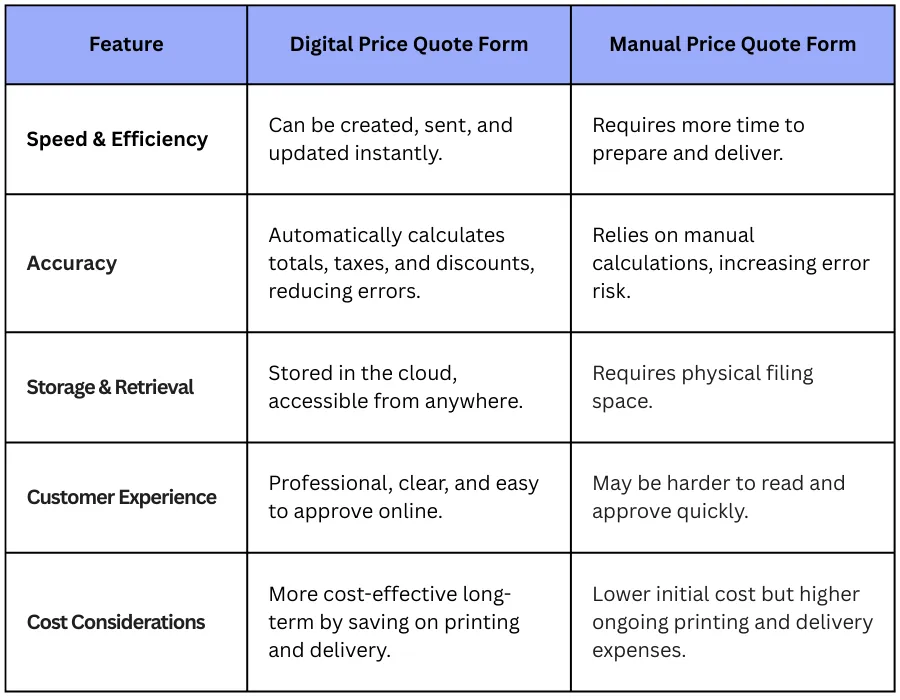How to Prepare a Price Quotation for companies [with Free Template Download]

Clear communication in pricing can be the difference between winning and losing a client. When every figure, term, and condition is presented in an organized manner. It removes uncertainty and builds trust from the first interaction. A price quote form achieves this by giving clients a complete view of what they will receive, when, and at what cost.
A well-prepared form helps avoid disputes, speeds up approvals, and sets the tone for a smooth business relationship by defining the scope of work, setting realistic timelines, and breaking down costs.
What is a Price Quote Form?
It is a formal document that a business provides to a potential client that outlines the cost of specific products or services before an agreement is made. It serves as a written confirmation of the proposed pricing, allowing the client to review and decide whether to proceed with the transaction.
Unlike an estimate, which is an approximate calculation, a price quote is generally fixed for a specific validity period and reflects the agreed conditions at the time it is issued. It is also different from an invoice, which is issued after the sale is completed.
Price quote forms are commonly used across industries, such as construction, manufacturing, professional services, and wholesale trading, where clarity in pricing is essential for decision-making. By detailing quantities, unit prices, applicable taxes, and terms, the form helps avoid misunderstandings and sets a clear foundation for the business relationship.
Key Components of a Price Quote Form
A professional price quote form should include all the essential information needed to ensure clarity, accuracy, and mutual understanding between the business and the client.
1. Business Details
- Name of the business or company issuing the quote.
- Address, contact number, email, and website.
- Logo and branding for professionalism.
2. Client Details
- Name of the client or organization.
- Contact information, including phone number and email.
- Reference number or client ID (if applicable)
3. Quote Number and Date
- A unique reference number for tracking and record-keeping.
- The date of the quote maintains a clear timeline.
4. Description of Products or Services
- Detailed breakdown of each item or service being offered.
- Quantity, specifications, and unit prices for transparency.
5. Pricing Breakdown and Total Amount
- Itemized costs per product or service.
- Subtotal, applicable taxes (e.g., VAT), and the final total.
6. Terms and Conditions
- Payment terms, delivery timelines, and warranties.
- Cancellation or refund policies.
7. Validity Period The time frame during which the quoted price remains valid, preventing future disputes over changes in cost
8. Signature and Approval Section Space for both parties to sign and confirm acceptance of the quote.

Download a free price quote Template
Why a Price Quote Form is Important for Businesses
A well-prepared price quote form does more than list prices—it plays a critical role in building trust, maintaining professionalism, and ensuring smooth business operations.
- Enhances Professionalism A professionally formatted quote shows the client that the business is organized and reliable. This positive first impression can influence the client’s decision to proceed.
- Builds Trust and Credibility Clear, transparent pricing fosters trust between both parties. Clients are more likely to commit when they fully understand the costs involved.
- Prevents Misunderstandings A detailed quote minimizes the risk of disputes over pricing, scope, or delivery terms. This helps maintain good client relationships and avoids legal complications.
- Speeds Up Decision-Making When all details are clearly stated, clients can make faster purchasing decisions. Reducing uncertainty shortens the sales cycle and improves cash flow.
How to Use a Price Quote Form Effectively in Business Negotiations
To maximize the effectiveness of a price quote form, businesses should follow these best practices:
- Keep It Clear and Concise and avoid unnecessary jargon or overly complex language. Use simple terms to make the quote easy to understand.
- Avoid Hidden Charges and keep transparency about all costs involved to build trust and avoid disputes later.
- Use Standardized Terms by incorporating common payment, delivery, and warranty terms to maintain consistency across quotes.
- Include all relevant details and ensure no important information is left out, such as taxes, deadlines, or product specifications.
- Maintain Records and keep copies of all sent quotes for future reference and audit purposes.
- Update templates regularly and review and revise your quote templates to reflect any changes in pricing, policies, or branding.
- Personalize When Appropriate and tailor the quote to the client’s needs and industry to make it more relevant and professional.
Common Mistakes to Avoid when preparing a price quote form
Avoiding common pitfalls when preparing a price quote form can save time, money, and reputation. Here are key mistakes to watch out for:
- Leaving Out Essential Details Omitting important information like delivery dates, payment terms, or tax details creates confusion and delays.
- Using Vague Descriptions General or unclear descriptions of products or services may lead to misunderstandings or disputes.
- Not specifying the Validity Period Clients may expect outdated prices or terms without a clear expiration date, causing conflicts later.
- Overcomplicating the Layout A cluttered or confusing form discourages clients from reviewing the quote carefully and may reduce trust.
- Ignoring Legal Requirements Failing to include necessary disclaimers or terms required by law can expose the business to risks.
Digital vs. Manual Price Quote Forms: Which is Better for Your Business?
The ability to prepare and deliver accurate quotes quickly can mean the difference between winning and losing a deal. While manual forms may feel familiar, digital forms offer automation, speed, and better record-keeping, making them increasingly favored by modern businesses. The table below compares the two approaches, so you can decide which aligns best with your company’s workflow, budget, and growth goals.

Key Differences Between Price Quote Form, Invoice, and Proforma Invoice
A price quote form often marks the starting point in business transactions, helping a buyer understand potential costs before committing. An invoice typically signals the final step, requesting payment for goods or services already delivered. By distinguishing clearly between the two, businesses can streamline negotiations, avoid misunderstandings, and maintain accurate financial records. The table below outlines these differences in a clear, side-by-side format.

Leveraging Technology for Efficient Price Quote Management with Wafeq
Technology has transformed how businesses create, manage, and deliver price quote forms. Using digital solutions like Wafeq streamlines the entire quoting process, reduces errors, and accelerates sales cycles. Here’s how Wafeq can help:
- Automated Quote Generation Wafeq allows you to quickly generate professional, customizable price quote forms, using templates that ensure consistency and accuracy.
- Real-Time Updates Prices, taxes, and product information update automatically in Wafeq, helping avoid mistakes and ensuring the client always receives the latest details.
- Easy Digital Delivery and Tracking Send quotes directly to clients via email or SMS from the platform, and track when they are opened or approved to follow up promptly.
- Integration with Invoicing and Payments Once a quote is approved, Wafeq can convert it seamlessly into an invoice, streamlining billing and reducing administrative workload.
- Centralized Records and Reporting Maintain organized records of all quotes to enable better analysis of win rates and client preferences, improving your pricing strategies.
How to Issue Price Quotations and Preliminary Invoices in Wafeq
Issuing price quotations and preliminary invoices in Wafeq is a straightforward process customized to save time and enhance accuracy. Follow these detailed steps to create and send a professional price quote:
- Click
Price Quotesfrom the main left-side menu, then press the+button at the top of the page. You will be directed to the price quote form, and Wafeq automatically generates a sequential quote number. - Select the currency for the transaction.
- Optionally, add purchase order what was received from the buyer.
- Choose the client’s contact from your list, or create a new contact directly within the quote form.
- Assign the quote to a specific project if needed.
- Set the date of the quote.
- In the products section, select or create the product you are selling (optional), write a short description of the product details, and choose the revenue account where the income will be classified (if you later convert the quote to an invoice) is usually an income account like sales. Finally, enter the quantity sold and the unit price, then add the VAT rate and discount if applicable.
- Specify the payment method details as you wish to receive payment. Optionally, add a stamp or signature to formalize the quote. Finally, click
Save and Sendto deliver the quote to your client.
Watch the following video to learn the exact steps:
Also Read: Sales Invoice: Definition, Importance, and Free Downloadable Template.
A well-structured price quote form is a fundamental tool that guides the sales process, builds trust, and ensures clear communication between businesses and their clients. Companies can streamline their operations, reduce errors, and close deals faster by understanding the differences between price quotes and invoices, mastering the essential components, and leveraging technology like Wafeq.
FAQs about Price Quote Form
What is a price quote form, and why is it important?
A price quote form provides a detailed estimate of costs before a sale and helps set clear expectations between buyer and seller. It is important for transparency and avoiding misunderstandings.
What information should be included in a price quote?
Key information includes item descriptions, quantities, unit prices, taxes, discounts, payment terms, validity period, and contact details.
How does a price quote differ from an invoice?
A price quote is an estimate provided before a sale is agreed upon, while an invoice is a formal request for payment after goods or services are delivered.
Can price quotes be legally binding?
Price quotes are generally considered offers and are not legally binding unless explicitly accepted by both parties in writing.
Send accurate, VAT-compliant price quotes and convert them into invoices instantly using the Wafeq Accounting Program.
Send accurate, VAT-compliant price quotes and convert them into invoices instantly using the Wafeq Accounting Program.








![Payment Vouchers Explained: Purpose, Format, and Best Practice [Free Template]](https://firebasestorage.googleapis.com/v0/b/wafeq-docs.appspot.com/o/medias%2F1af56400_سند الصرف_ الغرض والنموذج وأفضل الممارسات [مع نموذج مجاني].png?alt=media)

